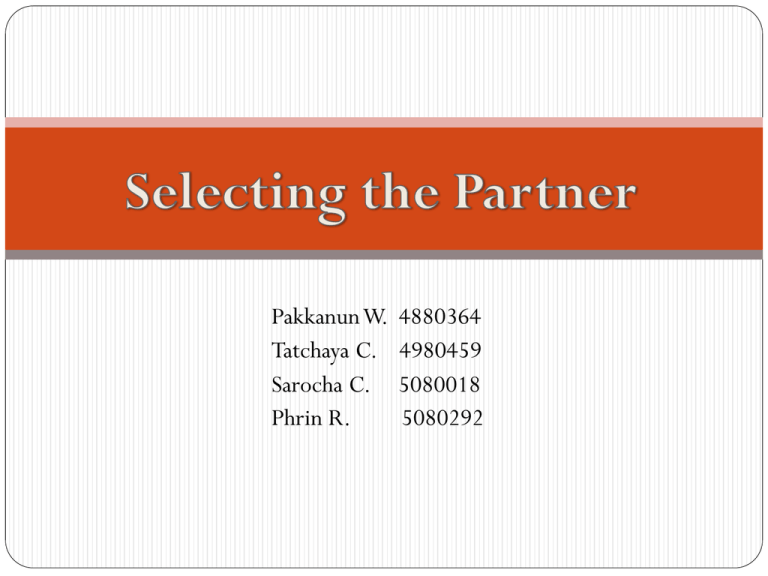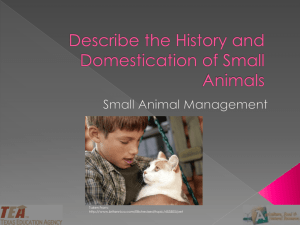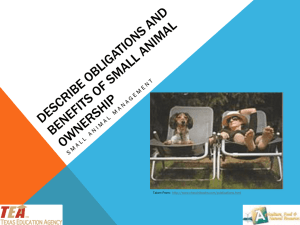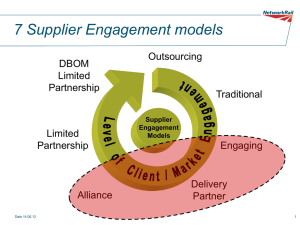Selecting the Partner
advertisement

PakkanunW. Tatchaya C. Sarocha C. Phrin R. 4880364 4980459 5080018 5080292 Selecting the Partner Finding a Partner Supplier Customer Professional &Trade association Newspaper & Trade magazine Seminars & Convention Internet Selecting the Partner Business Partner Selection Find a partner that: Share your values & vision Can bring skills & experience Offer resources & credibility Financially & functionally stable Good business ethics Selecting the Partner Qualities in a Partner Trust Tolerance Cooperation Commitment Mutuality The Alliance Framework Step1 Appointing the Planning and Negotiating team Step2 Achieving internal Consensus Step3 Approaching Potential Partners: Strategic Fit Assessment Step4 Conducting Resource Fit Assessment Step5 Step5 Selecting the the Partner Selecting Partner Step6 Negotiating an Agreement The Alliance Framework Step5 Selecting the Partner Which potential partner presents the least trouble some disagreements in Strategic Assessment Elements (SAEs), to be resolved in step 6 Final negotiations? Which potential partner provides the best match of required resources? Which potential partner has self-selected itself into the deal? The Alliance Framework Step1 Appointing the Planning and Negotiating team Step2 Achieving internal Consensus Step3 Approaching Potential Partners: Strategic Fit Assessment Step4 Conducting Resource Fit Assessment Step5 Selecting the Partner Step6 Negotiating an Agreement The strategic Fit Reconciliation Map 3 possibilities in dealing with SAE disagreements 1. Agree with the partner’s position 2. Convince the partner to agree to your position 3. Develop a compromise between the two positions Strategic Assessment Element (SAE) Our Firm’s Position Partner 1 Partner 2 Partner 3 Our Objectives Their Objectives Our Roles Strategic Fit Reconciliation Map Their Roles Our Overall Resources Their Overall Resources Boundaries Market Model Strategic Exclusivity Intersections Note: Symbol meaning OK = The partner accepts our position on the SAE. ? = We have a disagreement and are unsure of the resolution. Pet Food Company Alliance to incorporate novel nutrition ingredients into its pet foods Trying to find the best selected partners between company A and Company B The goal: to jointly develop a series of new products with a biotechnology firm Adding the biotechnology firm’s nutritional ingredients to the pet food company’s existing product lines and distribute the improved products through its distribution Following Step 3: Strategic Fit Assessment The Pet Food Company • Objectives: “The pet food firm will establish and maintain its reputation for innovation through sole branding of any jointly developed product.” • Market Model: “The customers will see the pet food company brand, not the biotechnology company’s brand, on the product.” Company A • Market Model: “Any jointly developed product will be cobranded.” Following Step 3: Strategic Fit Assessment The Pet pet Food food company The Company • Strategic Exclusivity Element: “The pet food firm will have global, perpetual, and sole rights to use the partner’s novel nutrients in pet food.” Company B B Company • Strategic Exclusivity Element: “Company B will give the pet food firm a oneyear exclusive right to use the nutrient, after which company B will be free to provide licenses to others.” Strategic Fit Reconciliation Map for Pet Food Alliance after Step 3 SAE Pet Food Company Position Our Objectives Sole brand Company A Market Model Sole brand Strategic Exclusivity Exclusive rights ? (cobranded) OK Company B Strategic Fit Reconciliation Map ? OK (cobranded) for Pet Food Alliance after Step 3 OK = The partner accepts our position on the SAE. ? = We have a disagreement and unsure of the resolution. OK ? (one-year head start) Resolving the Disagreements Looping back to the our objectives statements of step2 and other relevant elements. Challenged the original thinking with the new information. For example, Is sole branding necessary? Can the pet food company label the products as “jointly developed with company A” and still achieve its marketplace objective? Will a one-year head start allow the pet food firm to establish a strong enough foothold in the marketplace to fend off the competition? Step1 Appointing the Planning and Negotiating team Step2 Achieving internal Consensus Step3 Approaching Potential Partners: Strategic Fit Assessment Step4 Conducting Resource Fit Assessment Step5 Selecting the Partner Step6 Negotiating an Agreement Strategic fit Reconciliation Map for Pet Food Alliance after loop-back through step 2 SAE Pet Food Company Position Company A Company B Our Objectives Sole brand • OK Market Model Sole brand • OK OK X Strategic Exclusivity Exclusive rights OK = The partner accepts our position on the SAE. • = We have a disagreement, but the partner’s position is acceptable to us. X = We have a disagreement and cannot accept the partner’s position. Resource Fit Reconciliation Map Key Resource Company A Company B Ability to contribute to joint development of products based on preexisting nutrients OK OK+ Ability to provide technical support for jointly developed products OK OK Ability to develop future nutrients OK+ OK+ OK+ = The partner’s resources are outstanding and complementary to ours. OK = The partner’s resources are satisfactory and complementary to ours. Self selection: Selecting the Partner Intangible factor in partner selection When a firm’s people self selected themselves into the deal, the energy comes from self-motivation is tangible and translates into positive alliance results. “Self-motivation is critical to success. How did you assess the self-motivation of the partner in your last alliance” Selecting the Partner The Multiple Partner Option Sometimes, there are more choices qualified for alliance framework Step 2,3 and 4 negotiation can create multiple relationships with many companies. As the result Batelle’s MicroCats Alliance Tip for completing Selecting the Partner step 5 in alliance framework Step1 Appointing the Planning and Negotiating team Use strategic fit reconciliation map Step2 Achieving internal Consensus Step3 Approaching Potential Partners: Strategic Fit Assessment Step4 Conducting Resource Fit Assessment Step5 Selecting the Partner Step6 Negotiating an Agreement and resource fit reconciliation map to compare result of step 3 and 4 among potential partners Include motivation assessment as a partner selection area Loop back to step 2 to reassess your position in light of new information Select the best partner or moving ahead to step 6 Look back to step 3 and 4 for possible interpartner conflicts before step up to step 6






